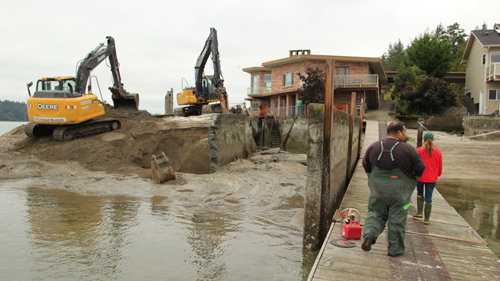Source: Northwest Treaty Tribes
The Squaxin Island Tribe is working with the South Puget Sound Salmon Enhancement Group to restore vital forage fish habitat by removing a 70-foot-long boat basin and a 137-foot-long boat ramp to reconnect a large drift cell along the shoreline.
“This kind of habitat, that forage fish use to spawn in, is critically important for deep South Sound,” said Scott Steltzner, salmon biologist for the Squaxin Island Tribe. A drift cell is a portion of shoreline that has a common source of sediment. When the habitat within these cells is disconnected, the actual amount of habitat available to forage fish can shrink.
The boat basin takes the form of a perpendicular cut into the beach near the mouth of Hammersly Inlet. Ten foot high walls were designed to protect a resident’s boat from the surf and tide and the boat ramp provided access to Puget Sound, but they also cause a lot of problems for what salmon like to eat.
After removing the concrete boat basin and ramp, the Tribe will restore the original slope of the beach, recovering the spawning habitat lost to forage fish This will allow sediment to naturally move supplying sediment to beach spawning forage fish and those off shore.
Forage fish, such as herring, sandlance, and surfsmelt, are important food for juvenile and adult salmon. Where they spawn marks critical habitat for salmon. “Forage fish spawn in the same places as juvenile salmon feed,” said Scott Steltzner, salmon biologist for the Squaxin Island Tribe. “Restoring this habitat will mean more food for salmon, which will help recovery depressed stocks.”
A few years ago, the tribe completed another fish friendly project when they replaced an aging, outdated boat ramp with a new ramp that would allow sediment to more naturally move. “This boat ramp is not only important to tribal fishers, but for shellfish companies and the general public,” said Andy Whitener, natural resources director for the tribe. “When we set out to replace it, it seemed fitting we’d do it in a fish friendly manner.”
In addition to providing more room for forage fish, nearshore habitat also provides important rearing areas for juvenile salmon before they move out to the open ocean. Nearshore habitat is a productive swath of land close in to the coast that serves an important role in the life-cycle of salmon.

